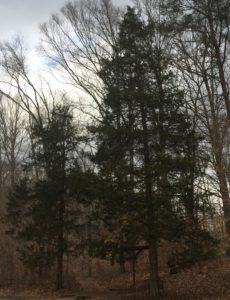By volunteer

While we watch the last days of winter slip away, we still have the opportunity to closely observe the trees in the natural forest that have held on to their green. Bernheim has a few species of pines that fit into that category as well as the native American holly. One of the most prominent of the evergreens, and one that often doesn’t get the respect it deserves, is the Eastern Red Cedar (alternatively written as redcedar).
This is certainly one of most easily identifiable trees in our forests. It’s scaly, deep green leaves (needles) look quite different from those of the pines. As does the reddish-brown to gray bark that peels off in narrow strips – and provides excellent bird nest building material. Even its cones are distinctive as they are heavily modified and closely resemble dark blue berries. These cones are a dietary staple for a number of bird species and other animals. While many of the cedars in the forest do not match the hardwoods in size, they are capable of living for several hundred years and growing much larger than their typical 30-50 foot height.
The red cedar does suffer from a bit of an identity crisis. Like a number of other trees, its common name does not match its true place in the world of trees. It is not actually a cedar, in fact there are no true cedars native to this continent. Those true cedars reside in Africa and Asia. The Eastern Red Cedar has the botanical name of Juniperus Virginiana and is a member of the cypress family. The red in its name refers to its fragrant heartwood. This is a common material for a number of products including paneling and furniture – the cedar chest being one very familiar example. It is very resistant to rot and is often used for outdoor applications such as fence posts. For decades it provided the wood to make the common pencil. When Henry David Thoreau went to Walden Pond because he “wished to live deliberately”, he was taking a hiatus from the family business of turning Eastern Red Cedar and graphite into pencils.
The value of this tree is not solely in the use of its wood. It has a medium growth rate and will thrive in a wide range of environments, particularly if there is adequate sunlight. Those qualities make it one of the key pioneer species in forest succession. It will quickly become established on land that was formerly deforested. If you had visited Bernheim in the 1930s or 1940s soon after this abused land was purchased by Isaac W. Bernheim, you would have found the pyramidal shaped red cedars to be one of the dominant trees in the young forest. As time went by, the native hardwoods returned to the land and began to take over. These oaks, hickories and others deprived the red cedars of the sunlight they needed. The survivors lost their pyramidal form as the lower branches died off. Now visitors to Bernheim will more likely discover Eastern Red Cedars growing along forest borders and roadways where the sun can still reach them.
Enjoy that splash of green that the Eastern red Cedar provides on your next visit to the forest. It has a key role in making that forest a healthy and flourishing ecosystem.
-Ken Johnson, Volunteer Naturalist

